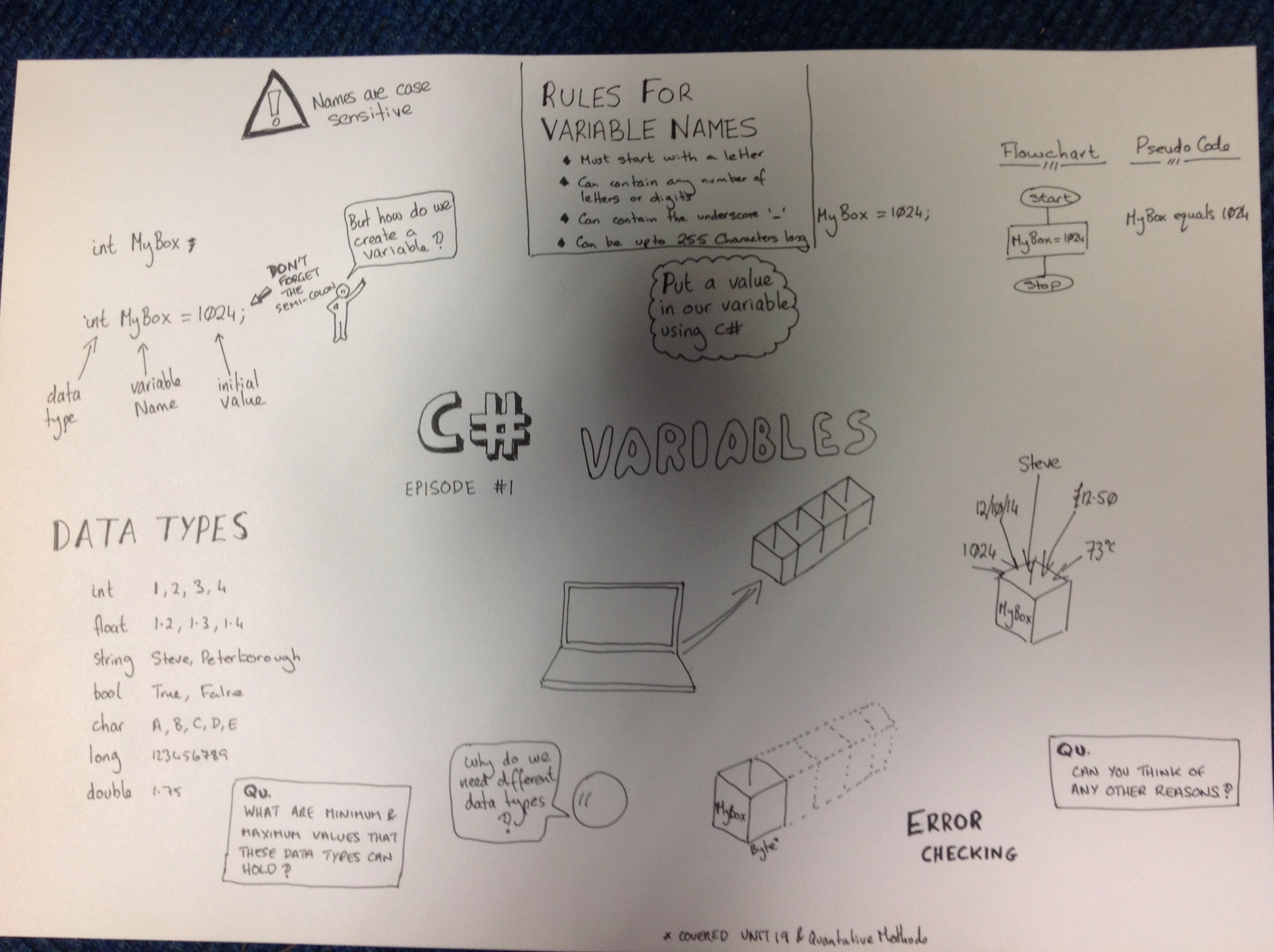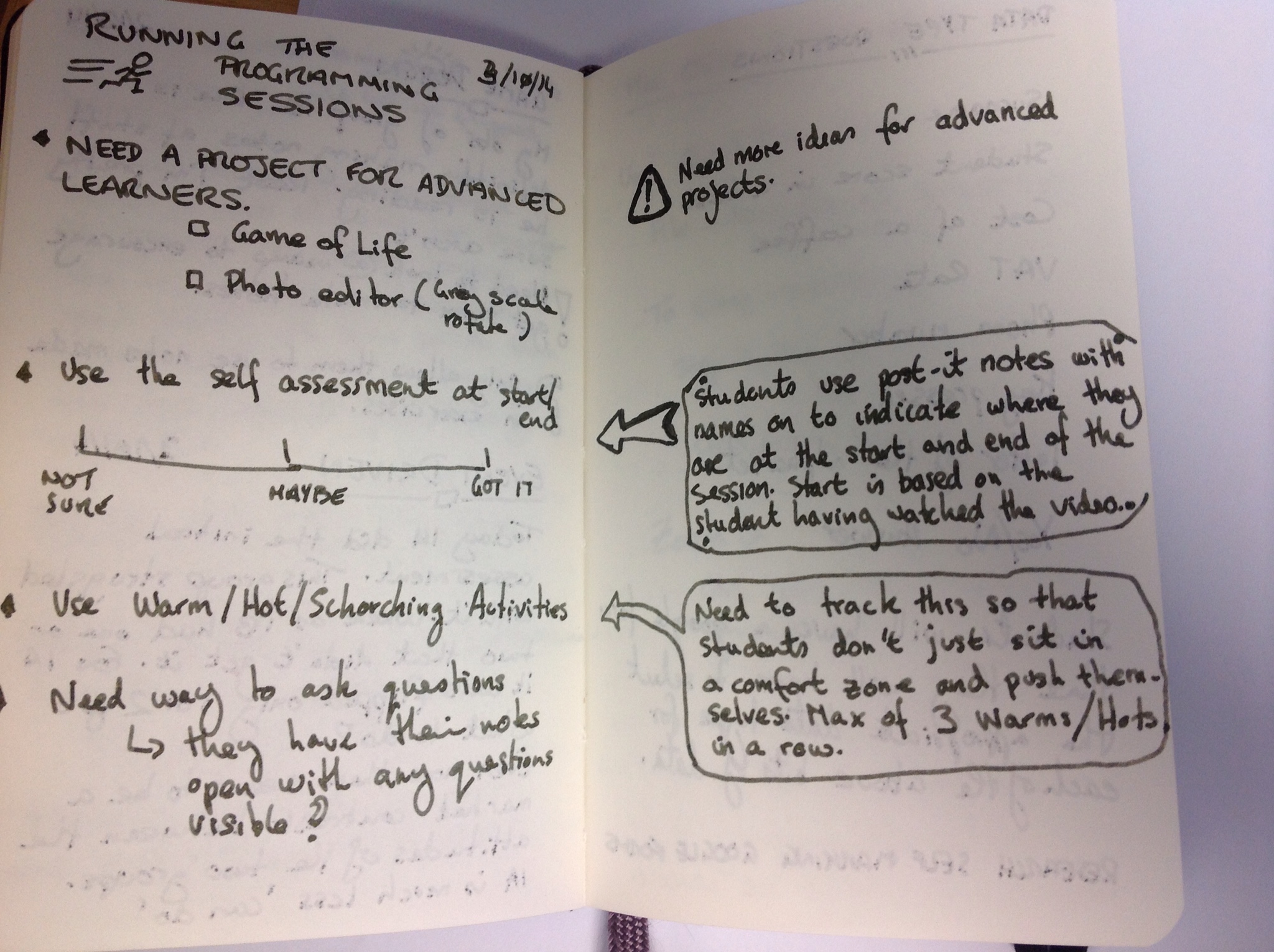In a previous post at the start of the Summer holidays I wrote a post about how I was going to give flipped learning a try in teaching programming to my year 1 level 3 students. The idea was that it would help the students in learning to program, encourage them to practice outside of the classroom, and allow the actual class time be spent on helping those students that need support and answering questions.
Towards the end of the Summer I got a moleskin notebook to use for recording notes about flipped learning, ideas, and a journal. And this is proving a useful thing to have handy. However my reading on the subject of flipped learning quickly expanded to included sketchnotes (visual note taking). I was particularly interested in this for use in the planned videos for explaining concepts and stuff in a hopefully visually way that would be more accessible for students. The outcome of this avenue of study is that I now have a small library load of books on this subject, and a need to allocate time in the day to expand my visual library. As part of my readings on the subject of flipped learning and improving my teaching of programming I have been reading Reflections on the teaching of programming: methods & implementations by Jens Bennesden, Michael E Caspersen and Michael Kolling. One of the initial articles in the book titled "Exposing the programming process" by Bennesden and Caspersen talks about process recordings which is basically a screencast of the development process with a tutor talking through their thought process while they tackle a programming problem. Which using teacher talk would be modelling. This is exactly what I aim to be doing with some of my planned videos.
In the flipped learning books I have (Flip Your Classroom, and Flipping 2.0) there is some great stuff on why, and recording sessions, and one of them goes on further taking the flipped learning to a Master model. However I found both books weak on the how to use the extra time in class, especially as I don't intend to implement the Master model of flipped learning. It took me a little while to get inspiration for what I would do with the timetabled lessons and how I would run them. However I did think of a format (ish) for the lessons which you can see with my illustrative journal/notebook entry above.
Before I started flipping the lessons I created a quick google form for the students to complete that looked at their previous programming experience, and their mindset. I followed this up with the students doing a test aimed at trying to determine a students aptitude towards programming. I want to try and use this data to see if there is a correlation between this initial data and how the student progresses learning to program.
My first video went up on variables in C# this week. This was a nightmare to produce. I've not really found an app that I like on the iPad (dislike Explain Everything and Videoscribe) for producing a "sketch cast" of my visual notes that produces a video that can be uploaded to YouTube. Although I believe that with Yosemite on the Mac I can record my iPads screen. Which would mean I could use Adobe Ideas to produce my sketch notes and record the process on my Mac. However that wasn't available so I had to resort to drawing the notes on a sheet of A3 paper (The photo at the top of the post is the finished notes), taking photos at key points, putting those photos into a presentation and then screen recording the presentation on the Mac using QuickTime Player and capturing my voice talking through the presentation. For the voice recording I had bought a Blue Snowball external USB mic, which on the default setting gave me a low volume and very static filled recording, while on the second setting although no static, the volume was still very low. I wasn't happy with this and need to investigate why this is happening. But at the time I had no time to do this, and resorted to using the inbuilt microphone of my Mac. The finished result isn't brilliant but just about passable. Once the teething problems have been sorted, time permitting I'll revisit these early efforts and "improve" on them.
The feedback has been mixed, the main negative comments were about production values, pauses and my voice! Well I am a bit monotone. One student asked if they could have a copy of the final A3 sheet, seeing as they were the only one to ask I gave them the original. Positive comments included that they liked the short length of it, and they thought it explained things well.
I know some of the students only watched the video in the break before the lesson. I need to get this corrected, as they are not getting the most out of this style of learning. They are definitely not making notes to refer back to later.
Anyway I think that sums the current state of play. I hope it hasn't been too dry, and there is some useful info buried in here somewhere for you.


No comments:
Post a Comment